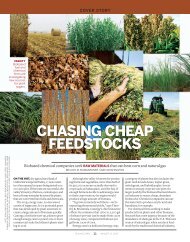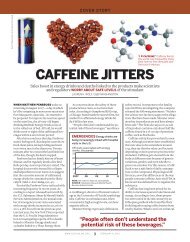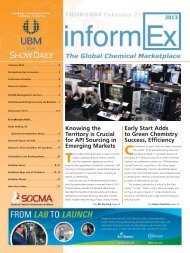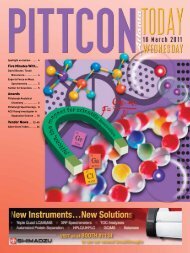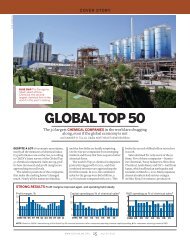focus on life sciences - Chemical & Engineering News - American ...
focus on life sciences - Chemical & Engineering News - American ...
focus on life sciences - Chemical & Engineering News - American ...
- No tags were found...
Create successful ePaper yourself
Turn your PDF publications into a flip-book with our unique Google optimized e-Paper software.
to ensure that they work, and the standardswill also include limits derived frommanufacturer data <strong>on</strong> actual products. But,Mire-Sluis notes, companies will be ableto justify using different tests or limits aspart of their drug applicati<strong>on</strong> package ifthey think their product merits somethingatypical.STRUCTURALLY, an antibody,or immunoglobulin, is a large,Y-shaped protein composedof two “heavy” and two “light”peptide chains. The heavychains come together at thebottom half of the Y, also calledthe crystallizable fragment, orFc. Disulfide b<strong>on</strong>ds and n<strong>on</strong>covalentinteracti<strong>on</strong>s hold thechains together. This part ofthe antibody has a c<strong>on</strong>servedamino acid sequence and bindsto receptors to activate partsof the immune system. Differentantibody classes—IgA,IgD, IgE, IgG, and IgM—havedifferent heavy chains that determinespecific immunologicalroles. IgG provides most of thebody’s immunity to invadingpathogens.At the top half of the antibodyY, the heavy chains branchout and each associates witha light chain, also through disulfideb<strong>on</strong>ds and n<strong>on</strong>covalentinteracti<strong>on</strong>s. This regi<strong>on</strong> of the antibodyis called the antigen-binding fragment,or Fab, and it is here that the amino acidsequence varies to bind to assorted foreignmolecules: Both arms of a specific antibodyhave the same amino acid sequence, whilethe variable porti<strong>on</strong> differs between differentantibody molecules.But because MAbs are made by cl<strong>on</strong>edcell lines with identical cells, all of the antibodiesproduced by a cell line engineeredfor producing a particular therapeuticshould be identical. M<strong>on</strong>ocl<strong>on</strong>al IgG therapeuticswere originally based <strong>on</strong> mouseantibodies, but they now can be chimeric,which means a part-mouse/part-humansequence, or “fully” human. Structurally,the three types are very similar, but theymay provoke different immune resp<strong>on</strong>sesin patients.In additi<strong>on</strong> to their basic structurallikeness, MAb therapeutics also tend tobe purified similarly, USP’s Morris notes.Purificati<strong>on</strong> typically starts with affinitychromatography using a solid phase thatanchors protein A, a bacterial proteinthat selectively binds to the antibodies’c<strong>on</strong>served Fc regi<strong>on</strong>. After that, the drug islikely treated to inactivate any c<strong>on</strong>taminatingviruses and may undergo fine-tuningpurificati<strong>on</strong> steps. Most antibodies arealso currently produced from two popularcell lines, which means that their impurityCONFIGURATION The basic IgG structure involvestwo heavy chains and two light chains held together bydisulfide b<strong>on</strong>ds and n<strong>on</strong>covalent interacti<strong>on</strong>s. The proteinmay be glycosylated at a c<strong>on</strong>served site (shown) orelsewhere <strong>on</strong> the structure.SSSSSSOligosaccharideHeavy chainVariable ◼C<strong>on</strong>served ◼Light chainVariable ◼C<strong>on</strong>served ◼SSSSSSSSprofiles are similar. The combinati<strong>on</strong> ofsimilar cell culture and purificati<strong>on</strong>, <strong>on</strong> topof targeting the same protein, further lendsanalysis of MAb therapeutics to similarprotocols, Morris says.But despite these similarities, MAbsmay show heterogeneity depending <strong>on</strong>how they were produced and processedby their originating cells. Problems withDNA translati<strong>on</strong> or transcripti<strong>on</strong> may leadto different protein sequences. Proteinsmay misfold or mismatch their disulfideb<strong>on</strong>ds. Posttranslati<strong>on</strong>al modificati<strong>on</strong> mayproduce different glycosylati<strong>on</strong> patterns.Side chains may also be subject to chemicalreacti<strong>on</strong>s, such as oxidati<strong>on</strong> or deamidati<strong>on</strong>.Proteolytic enzymes may clip theprotein, especially the lysines at the ends ofthe heavy chains in the Fc. MAbs may alsodenature or aggregate as they go throughpurificati<strong>on</strong> or formulati<strong>on</strong>.Because of these effects, even a perfectlyprepared MAb therapeutic will includeIgG proteins with varied structuresWWW.CEN-ONLINE.ORG 17 MARCH 2012SSSSSSSand properties, says William Whitford,senior market manager for cell culture andbioprocessing at Thermo Fisher Scientific .“Unlike small-molecule drugs, biologicsshow a distributi<strong>on</strong> of slightly differentmolecules,” he says. The analytical challengeis therefore to ensure that the populati<strong>on</strong>distributi<strong>on</strong> doesn’t vary significantlyfrom the drug that was developed,tested clinically, and approved.SOligosaccharideSSSOME PROPERTIES are aprocess red flag. Oxidati<strong>on</strong> ordeamidati<strong>on</strong>, for example, byitself generally doesn’t affectan antibody’s clinical functi<strong>on</strong>,says Raym<strong>on</strong>d Kaiser,global science leader and vicepresident for biotechnologyservices at Covance , a c<strong>on</strong>tractdrug development company.But variability in those categoriesis usually a sign thatthe manufacturing process isnot well c<strong>on</strong>trolled, and otherprotein characteristics, such asaggregati<strong>on</strong>, may be affected,Kaiser says.Other modificati<strong>on</strong>s are aclinical c<strong>on</strong>cern. A misfoldedprotein or <strong>on</strong>e with abnormaldisulfide b<strong>on</strong>ds probably w<strong>on</strong>’thave the structure needed tofuncti<strong>on</strong> properly. Additi<strong>on</strong>ally,IgGs have a c<strong>on</strong>servedglycosylati<strong>on</strong> site <strong>on</strong> the Fc,but variati<strong>on</strong>s in those sugars and glycosylati<strong>on</strong>elsewhere <strong>on</strong> the protein may elicitan unwanted immunological resp<strong>on</strong>se,such as anaphylaxis. Protein aggregatesmay also provoke an immune resp<strong>on</strong>se.And so a suite of analytical tests is necessaryto ensure that a MAb therapeuticis within the bounds of the drug that wasoriginally prepared, tested, and approved.“You live and die by your analyticals,” Kaisersays. “If you d<strong>on</strong>’t have your analyticals,you d<strong>on</strong>’t know anything.”The first order of business is often toidentify whether a manufacturer has madethe correct protein. One comm<strong>on</strong> approachis to do an immunoassay, such asan enzyme-linked immunosorbent assay(ELISA). In these types of assays, a stati<strong>on</strong>arysolid phase is loaded with a moleculethat will bind specifically to the target antibody.A drug sample is loaded, incubated,and washed, and some sort of label is usedto assay whether and how much of the targetantibody is bound.



